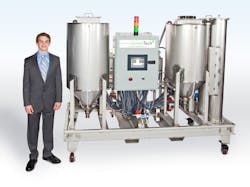Most of the projects featured in our Engineering School Innovations section are created for college-level engineering courses. But Sam Flournoy’s story, even though it was not connected to a school project, caught our attention. After all, the thoughts of most 14-year-old boys are often nowhere near biofuel generation. But in 2009, that’s just where Sam Flournoy’s thoughts were.
The processor Flournoy designed works as follows: To begin, the processor pumps in 60 gallons of waste vegetable oil, then heats it up to 145 degrees Fahrenheit. While the oil is heating, the machine pumps in 13 gallons of methanol into a separate tank. The user tests the oil to determine how much potassium hydroxide needs to be added. The processor then mixes the methanol and potassium hydroxide together to form methoxide. After the oil has been heated up to 145 degrees, the methoxide is mixed into the oil for about an hour. Then the oil and methoxide mixture is allowed to settle for two hours. Two layers then form, with glycerin on the bottom and biodiesel on the top. The glycerin is drained off and the biodiesel is pumped into the methanol evaporation tank. The biodiesel is heated to 180 degrees to evaporate off and reclaim any excess methanol from the fuel. Excess methanol is recovered from the biodiesel and re-used in the next batch. The fuel is then pumped through two filters with special media to clean the fuel. The resulting fuel is crystal clear and ready to be used in a diesel engine.
As soon as the glycerin is drained off and the biodiesel is pumped into the methanol evaporation tank, a new batch can be started for near continuous operation of the unit.
Explaining the automated functions of the processor, Flournoy notes that Automation Direct “graciously donated many parts that I needed back when I was creating my first processor. The processor uses an Automation Direct DL06 PLC. An operator only needs to press one button and the machine will turn 60 gallons of used vegetable oil into 60 gallons of biodiesel fuel that can be used in almost any diesel engine.”
The conversion process takes about four hours.
“The PLC monitors the whole process with temperature controllers and pneumatically actuated valves,” Flournoy says. “If the PLC notices a problem, such as a valve getting stuck or a temperature probe malfunctioning, the PLC will safely shut down the operation and notify the operator.”
Flournoy adds that the unit can hold up to 66 lbs. of dry wash media and all plumbing, pump heads and valves are 304 stainless steel to “ensure the best chemical reaction.”
The video below illustrates operation of the Flournoy Green Tech automated biodiesel processor.
Leaders relevant to this article:


